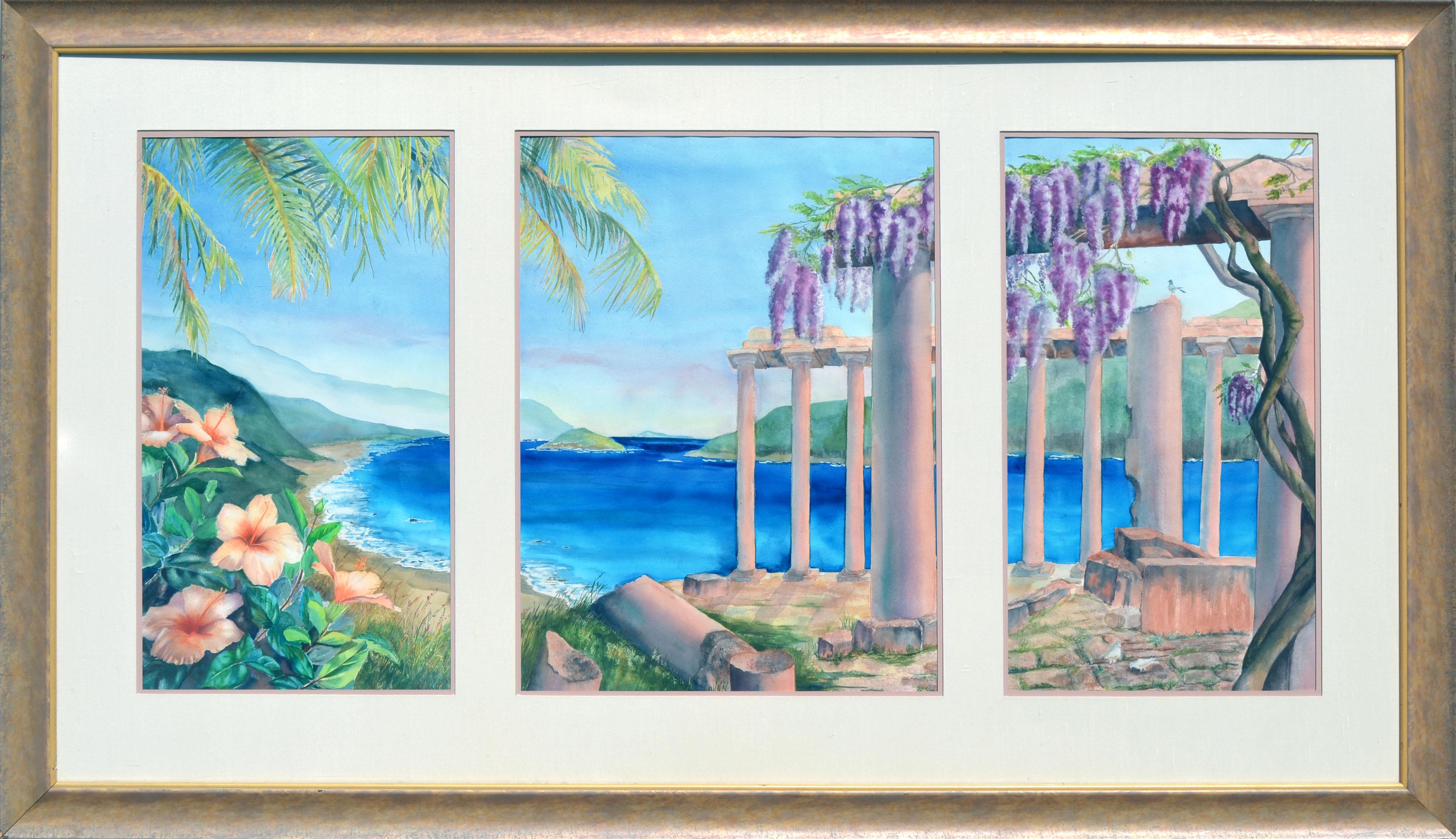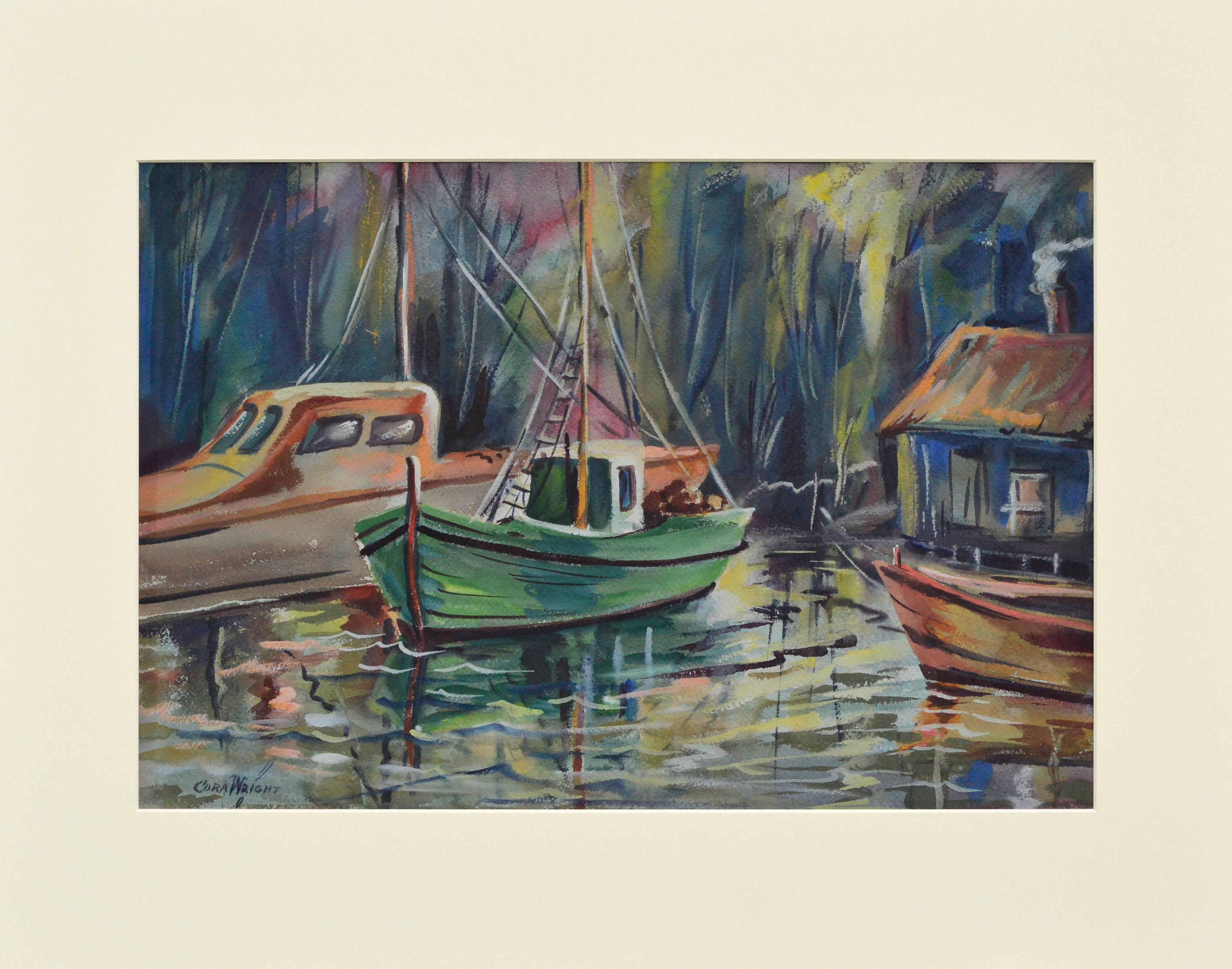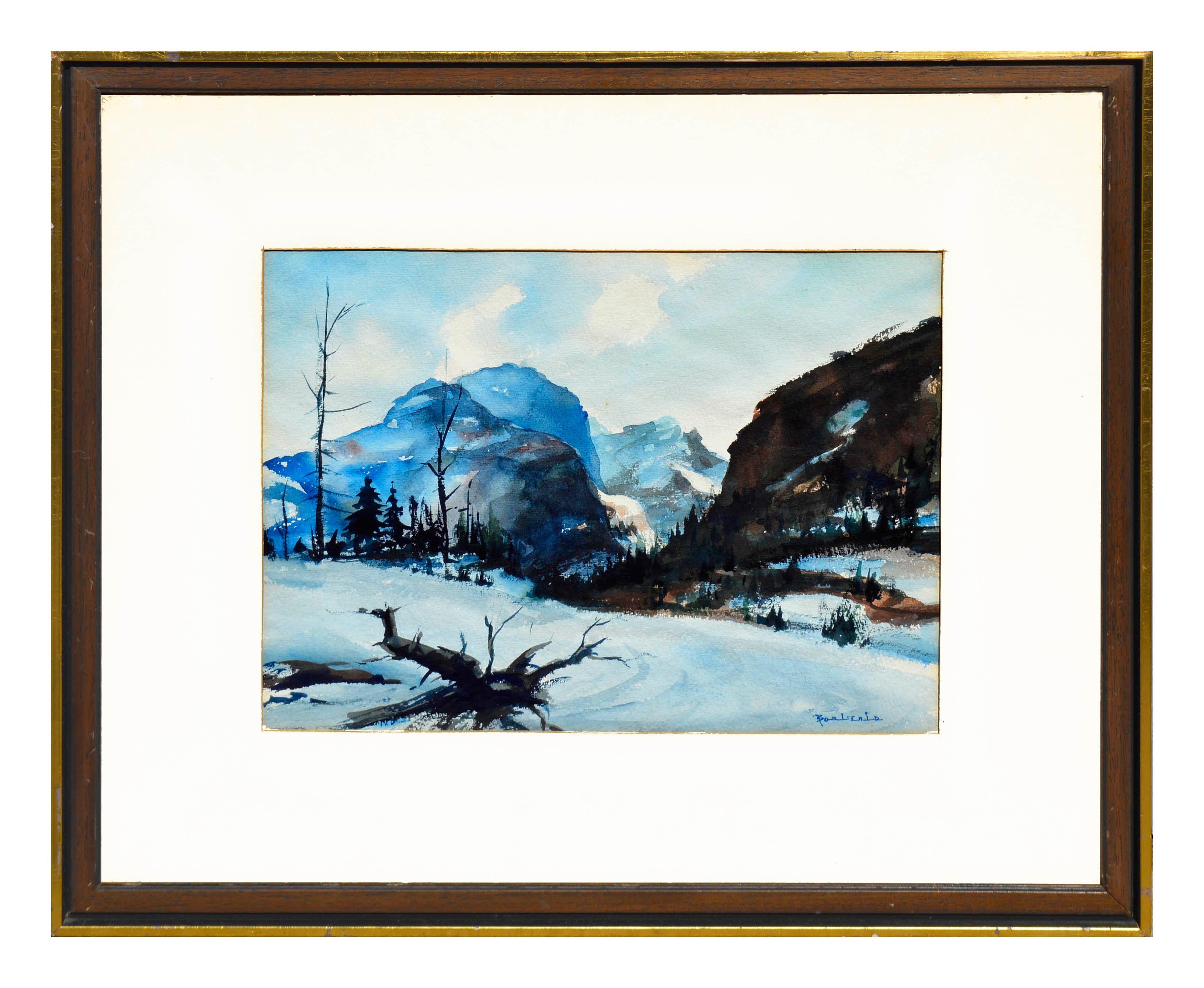Items Similar to Bonnieux Village Luberon France
Want more images or videos?
Request additional images or videos from the seller
1 of 12
Marilyn H HeilprinBonnieux Village Luberon France 2000s
2000s
About the Item
Bonnieux Village Luberon France
Bright and expressive white line woodcut in watercolor of Bonnieux Village Luberon France by Marilyn Heyman Marilyn H. Heilprin, (American, 1926-2020). Heilprin is an author, poet and artist from Bethesda, Maryland. Signed lower right "Marilyn Heilprin, titled lower left "Bonnieux WC 3 (watercolor #3).
Marilyn Heilprin was born in New York City and has a B.A. from Smith College (1948) and M.A. in international relations from The American University (1963). A former research associate, writer and editor for federal agencies and private publishers, she attended writing workshops at Breadloaf, The American University, and Writers' Center in Bethesda, MD. She has published poems in literary journals and was a finalist in the Maryland State Poetry and Literary Society chapbook contests. She co-authored Leo Saal's memoir "Crossings: A Life in Russia and Germany in the First Half of the 20th Century." Feb. 2020, Marilyn Heilprin, 93, a retired editor, writer and researcher who created one of the earliest compendiums of international statistics and organizations.
Image, 9"H x 12"W
Sheet, 14.5"H x 16.5"W
Frame, 15.25"H 17"W x .5"D
Mrs. Heilprin, a former resident of Bethesda, Md., was born Marilyn Heyman in New York City. In the 1950s, she was a researcher and writer on handbooks about Mongolia, Finland, Germany, Austria, Lebanon, Syria and Israel for the Washington-area branch of the Human Relations Area Files, a nonprofit formed by several universities. The "Provincetown Print", a white-line woodcut print. Rather than creating separate woodblocks for each color, one block was made and painted. Small groves between the elements of the design created the white line. Because the artists often used soft colors, they sometimes have the appearance of a watercolor painting.
Marilyn Heilprin, Ruth Cahnmann, George Chung, Susana deQuadros, Susan Due Pearcy, Leo Saal and Ann Zahn are straightforwardly about the figure. One might even say it's about the act and traditions of painting the figure. Dubbing themselves the "Somerset Seven," the group meets periodically to paint from a model at Leon Saal's studio in Somerset, and later at Ann Zahn's studio.
Leo Saal joined the CIA and came to the United States, settling in the Washington area. After retiring from the agency, he devoted himself to art. He was a founding member of such cooperative galleries as the Printmakers Gallery of Washington and Creative Partners in Bethesda. His work also was exhibited in other local galleries, including the Strathmore Hall Arts Center in Bethesda.
White Line Woodcut Printing: Provincetown Printers were a group of artists, most of them women, who created art using woodblock printing techniques in Provincetown, Massachusetts during the early 20th-century. It was the first group of its kind in the United States, developed in an area when European and American avant-garde artists visited in number after World War I. The "Provincetown Print", a white-line woodcut print, was attributed to this group. Rather than creating separate woodblocks for each color, one block was made and painted. Small groves between the elements of the design created the white line. Because the artists often used soft colors, they sometimes have the appearance of a watercolor painting.
Bror Julius Olsson Nordfeldt has been credited with developing the technique, based upon Japanese ukiyo-e woodblock printing, though there is evidence that a lesser-known Provincetown artist, Edith Lake Wilkinson, was making white-line prints in 1913, a year earlier than Nordfeldt's first known efforts.[5] Blanche Lazzell is said to have mastered the technique.
Bill Evaul, a writer for Print Review in the late 1970s, was asked to write an article about "printmaking in Provincetown", but by that time many of the artists were no longer alive. Through research with Myron Stout and meeting with some surviving members, like Ferol Sibley Warthen, he learned the history about the Provincetown Print and later learned how to create works of art with the technique. Since then, he has promoted the white line woodcut technique in his historical research paper "Provincetown Printers: Genesis of a Unique Woodcut Tradition", taught and lectured about the technique, and has created and shown his version of the Provincetown Prints in exhibits.[10]
- Creator:Marilyn H Heilprin (1926, American)
- Creation Year:2000s
- Dimensions:Height: 15.5 in (39.37 cm)Width: 17 in (43.18 cm)Depth: 0.5 in (1.27 cm)
- Medium:
- Movement & Style:
- Period:
- Condition:Excellent paper and acid free mat. Aluminum frame is included as-is, my have some minor surface scratches. Plexiglas included.
- Gallery Location:Soquel, CA
- Reference Number:
About the Seller
4.9
Platinum Seller
These expertly vetted sellers are 1stDibs' most experienced sellers and are rated highest by our customers.
Established in 1986
1stDibs seller since 2014
2,545 sales on 1stDibs
Typical response time: <1 hour
- ShippingRetrieving quote...Ships From: Soquel, CA
- Return PolicyA return for this item may be initiated within 14 days of delivery.
More From This SellerView All
- Minimalist Mid Century Modern Landscape -- Autumn TreesLocated in Soquel, CAMinimalist mid-century modern landscape of three autumnal trees by M. Lehtio (American, 20th century). Signed "M. Lehtio" and dated "48." Presented in a wood frame and non-glare glas...Category
1940s American Impressionist Landscape Paintings
MaterialsWatercolor, Laid Paper
- Mid Century Tonalist Landscape of California Country RoadLocated in Soquel, CABeautiful tonalist landscape of California foothills and country road. Signed and dated "CKP" and "'69" lower right corner. Presented in rustic wood frame with eggshell mat under nonglare glass. Image size: 18.25"H x 13.25"W. Framed size: 23.5"H x 18"W. California Tonalism was art movement that existed in California from circa 1890 to 1920. Tonalist are usually intimate works, painted with a limited palette. Tonalist paintings are softly expressive, suggestive rather than detailed, often depicting the landscape at twilight or evening, when there is an absence of contrast. Tonalist paintings could also be figurative, but in them, the figure was usually out of doors or in an interior in a low-key setting with little detail. Tonalism had its origins in the works of the French Barbizon school and in the works of American painters who were influenced by them. California Tonalism was born when the emphasis in California landscape painting passed from the grand landscapes of works like those of Thomas Hill and William Keith's early career, to more intimate views of a domesticated landscape. At the same time, the parallel Pictorialist Photography...Category
1960s American Impressionist Landscape Paintings
MaterialsGouache, Laid Paper
- Large Scale Triptych Watercolor Landscape -- Paradise CoveLocated in Soquel, CAA secluded ancient site with lush foliage overlooking a brilliant blue cove is the subject of this watercolor triptych combined in single framing by artist Isabel McCauley...Category
1990s American Impressionist Landscape Paintings
MaterialsWatercolor, Laid Paper
- Mid Century Fishing Boats LandscapeLocated in Soquel, CAVibrant watercolor of three fishing boats by Cora Alice Akers Wright (American, 1908-1992). which are anchored in a small body of water. Signed...Category
Early 20th Century American Impressionist Landscape Paintings
MaterialsWatercolor, Laid Paper
- Yosemite Tuolumne Meadows in Winter LandscapeLocated in Soquel, CAGorgeous watercolor winter landscape of Yosemite's Tuoloumne Meadows by Dorothy Watkeys Barberis (American, 1918-1998). Unframed. Signed "Barberis" lower right. Image size, 12"H x 15"L. Dorothy Barberis was born on September 20, 1918 in Newport News, Virginia. National Association Women Artists, National Arts Club, Salmagundi, New York Artists Equity, Mid-West Watercolor Society, Southwest Watercolor...Category
1970s American Impressionist Landscape Paintings
MaterialsWatercolor, Laid Paper
- 1930's California Watercolor Landscape -- "Palm Trees"By Margaret E. RogersLocated in Soquel, CAWonderful 1930s watercolor California landscape with iconic palm trees by Santa Cruz artist Margaret E. Rogers (American, 1872-1961). Titled "Palm Trees" and signed "Margaret Rogers" on verso. Presented in a wooden frame. Image, 14"H x 12"L. Born in Birmingham, England on May 1, 1872, the Rogers family immigrated to California in 1875 and established a prosperous sheep ranch in Monterey County. In her youth Margaret was known as one of the finest horsewomen in the West. The magazine Western Woman...Category
1930s American Impressionist Landscape Paintings
MaterialsWatercolor, Laid Paper
You May Also Like
- Canal at Indian Mound RoadBy Ben FenskeLocated in Sag Harbor, NYPainted during the 2015 Winter Equestrian Festival in Wellington, Florida. A black and white depiction of a canal, is barely recognizable, due to Fenske's wild brushstrokes and lack...Category
21st Century and Contemporary American Impressionist Landscape Paintings
MaterialsGouache, Paper
- Bali LandscapeLocated in Columbia, MOBenjamin Cameron spent 48 years teaching students in Columbia across three different colleges. His own works still hang on the walls around the community and tell a greater story of ...Category
21st Century and Contemporary American Impressionist Landscape Paintings
MaterialsWatercolor, Archival Paper
- Southern LandscapeLocated in Milford, NHA fine gouache painting of a Southern landscape by American artist Beatrice Lavis Cuming (1903-1975). Cuming was born in Brooklyn, NY, studied lo...Category
Mid-20th Century American Impressionist Landscape Paintings
MaterialsPaper, Gouache
- Homestead, Regional American Landscape by Pennsylvania ImpressionistBy Harry Leith-RossLocated in Doylestown, PA"Homestead" is a regional, American landscape by Pennsylvania Impressionist and New Hope School painter Harry Leith-Ross. The painting is a 14" x 19" watercolor on paper, signed "Lei...Category
1940s American Impressionist Figurative Paintings
MaterialsWatercolor, Archival Paper
- "Old Adobe Village, New Mexico" Alice Schille, Taos Pueblo, Female ImpressionistBy Alice SchilleLocated in New York, NYAlice Schille Old Adobe Village, New Mexico Signed lower right Watercolor on paper 5 x 6 inches Provenance: Estate of the artist Keny and Johnson Gallery, Columbus, Ohio Santa Fe East Galleries, Santa Fe, New Mexico Private Collection, California A painter in watercolor and oil, Alice Schille was a prolific artist using modernist styles of Post-Impressionism, Pointillism and Fauvism. Her subjects included portraits of women and children, landscapes with and without figures, a series of scenes of New York City. New Mexico, and Gloucester, Massachusetts. Her paintings also reflected her widespread international travels in Europe, North Africa, Russia, the Middle East, Mexico, and Guatemala. Although personally very shy, Schille possessed unusual courage and strength of will, which was reflected in both her independent lifestyle and in her work, as she continually worked to master new modes of painting throughout her career. A German critic once referred to Schille as "this daredevil disciple of art who is interested in anything and afraid of nothing." Alice Schille was born in Columbus, Ohio to a family supported by her father's success in manufacturing. She was raised in Columbus, and by the time she was age six, she determined to be an artist. She graduated at the top of her class from Central High School in 1887, studied from 1891 to 1893 at the Columbus Art School, and returned there as a teacher from 1902 to 1948. Going to New York City as a young woman, she enrolled in the Art Students League from 1897 to 1899 and then the New York School of Art with William Merritt Chase and Kenyon Cox. (Some years later, she attended Chase's Shinnecock Summer School on Long Island). From 1903 to 1904, Alice Schille was in Paris at the Academie Colarosi, and also studied privately with Raphael Collin, Rene Prinet, Gustave Courtois and Chase, who was then in Europe. In 1904, five of her paintings were accepted for exhibition at Societe Nationale des Beaux Arts, and from that time on her work was included regularly in important American annual exhibitions including the Pennsylvania Academy, the Corcoran Gallery, American Watercolor Society, Boston Art Club, and the 1987 inaugural exhibition of the National Museum of Women in the Arts in Washington DC. Between 1905 and 1914, Alice Schille painted in Europe, and during the summers of 1916 to 1918, worked in New York and Gloucester. In 1919, she was in New Mexico. On this trip, her first to the Southwest, she spent a summer in Taos and Santa Fe and painted scenes including the Taos Pueblo, Canyon Road and local Hispanic and Indian figures. Reportedly the Ranchos de Taos Church was one of her favorite subjects. Many of these New Mexico paintings were hung at annual exhibitions of the Philadelphia Water Color Club. Between 1920 and 1940, she traveled frequently in the summers, returning to New Mexico and going to Central America and Africa. In 1922, she began her first series of North-African watercolors...Category
1920s American Impressionist Landscape Drawings and Watercolors
MaterialsPaper, Watercolor
- Study for Skunk Cabbage, Watercolor Painting by Charles Burchfield 1931By Charles E. BurchfieldLocated in Long Island City, NYA watercolor painting by Charles Burchfield from 1931. A still life botanical painting of a skunk cabbage in natural setting. Signed and dated in lower right, beautifully matted and framed in gold ornate frame. The painting has an excellent provenance through top New York Galleries including DC Moore...Category
1930s American Impressionist Landscape Paintings
MaterialsWatercolor, Paper
Recently Viewed
View AllMore Ways To Browse
French Village Painting
European Village
Landscape French Village
German Village
Japanese Village
European Village Landscapes
Woodblock Landscape
20th Century French Woodcuts
French Leo
Japanese Landscapes Woodblock
Japanese Woodcut Landscape
1950s Marilyn
E M Washington
Provincetown Print
Susan George
Writers Block
Bill Ely
Painting Blanche American





